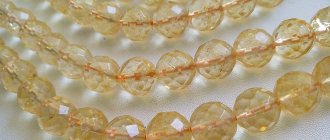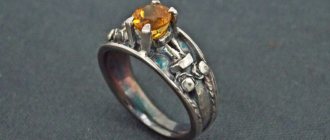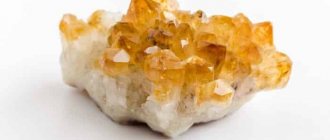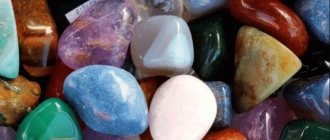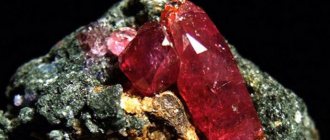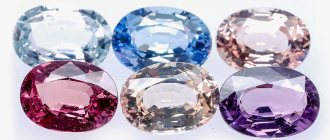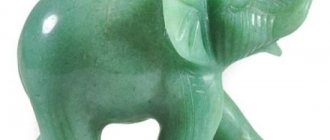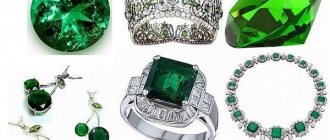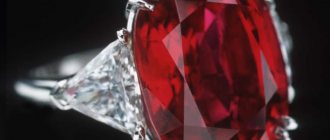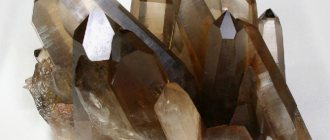Citrine is a type of quartz with warm sunny shades. The stone has a long history, but until the 18th century it was considered golden topaz, which it resembles in appearance. It is interesting that naturally colored gems are rare in nature - most jewelry stones are obtained as a result of refining other varieties of quartz.
Decorations
Story
Citrine is a rare representative of the quartz family of minerals.
For centuries, the citrine stone did not have a name. It was considered and called topaz: Spanish, Bohemian, Western. The name was established in the 18th century and is translated from Latin and European languages as “lemon yellow.”
VIPs were decorated with gold-colored crystal seals for confidential documents.
Physical properties
Citrine is formed similarly to quartz, so their characteristics are similar:
- it is silicon dioxide;
- glass luster;
- hardness above average (7 out of 10);
- forms druses from crystals, grains, granular aggregates;
- dissolves with hydrofluoric acid;
- piezo and dielectric;
- specimens are transparent, but the crystal structure may have partial opacities;
- cracks, opaque inclusions.
The yellow color is caused by impurities or defects that occur during chemical processes in the stone. Easy to handle, but scratches glass. May become discolored in the sun.
A little science
From a brief historical excursion, let’s move on to the physical and chemical properties of citrine stone. It is based on silicon oxide, as, in fact, all quartz. Specific honey, lemon and golden tones are provided by ionic impurities of lithium, aluminum, iron and hydrogen. Citrine crystals, as a rule, are quite large in size or grow together to form druses. On a 10-point Mohs hardness scale, this mineral is rated at 7.
The largest citrine mines are located in Brazil and Madagascar.
Smaller deposits are found in the Perm region, on the South Ural spurs in Kazakhstan, as well as in Poland, Spain and France.
Where is citrine mined?
Citrine is the rarest stone in the quartz family. It is found in both Americas (USA, Uruguay). The number one producer in the world is Brazil. Here they found the largest citrine in history weighing 2258 carats (450 grams), stored in the USA.
The island state of Madagascar replenishes its treasury with pebbles. In Europe, citrine stones are mined in France, on the Iberian Peninsula, and in Russia (in the Urals).
Colors and varieties
The classic color of the stone is created by iron, silicon and aluminum. The ratio of components determines the range from pale lemon to amber. The description of a specific instance includes an indication of color.
The pale yellow mineral is considered natural. Other specimens, of greater brightness and saturation, were obtained after heat treatment of smoky quartz (bright yellow), morion or amethyst (orange and brown).
Thick, sunny orange Madeira citrines are named after the color of the wine of the same name. Essentially it is burnt morion or amethyst.
Wine-yellow citrine stones are obtained by calcining Brazilian amethysts. This variety is also called palmyra, madera, sierra or bahia topaz.
The most common is yellow, rare expensive stones of the citrine variety are pale yellow and green. Ametrines are valued - crystals with alternating segments of citrine and amethyst colors. They are found in Bolivia, but rarely.
Palette and subtypes
Looking at a photo of a citrine stone, we can find that its color palette is quite diverse: from transparent light yellow tones to “thick” and deep amber, reminiscent of honey from herbs. Gemologists call light citrine “Bohemian topaz,” and dark citrine “Spanish.” It is worth noting that the natural color of the mineral is close to lemon; more saturated shades are nothing more than the result of heat treatment.
There is also a light green variety of the stone, sometimes called false emerald, but the characteristic green tint disappears when exposed to the sun, so it has not gained any special status or attention.
But another rare modification of citrine, its cross with amethyst, naturally called ametrine, is extremely valuable because of its unusual striped color, alternating lilac and light yellow.
Magic properties
The magical power of the stone helps a person in all areas of life. It will improve your financial situation, attract good luck, and help you maintain composure in force majeure situations.
The magical properties of citrine equally reliably protect respectable people and notorious scoundrels:
- He imparts cunning, so swindlers and swindlers of all stripes consider him theirs.
- People with an exaggerated sense of justice and honesty will be disappointed.
- It pulls you out of depression, raises self-esteem, and puts your thoughts in order.
- Indispensable when thinking about decisions.
- It has the color of gold - the main material attribute of wealth. This means having a citrine crystal or druse in your wallet or cash safe. Then the money will increase, and profitable deals are guaranteed.
- This is a family stone that brings harmony and warmth to the home.
- Yellow crystal is indispensable for children. The amulet worn by the mother has a special meaning - it will protect you from troubles and help you throughout your life.
- For practitioners of magic, citrine enhances intuition and increases strength.
- In China, it is the carrier of male Yang energy.
Main characteristics and properties of the mineral
Citrine is a mineral with rather modest properties and characteristics. Its hardness rating is 7 on the Mohs scale, which prevents accidental scratches or chips. There are no adhesions in it, and it also has a high degree of transparency. It occurs in the form of large crystal aggregates and boasts a glassy, light luster.
Natural citrine has the following properties:
- Increases the owner's immunity;
- Improves and stimulates brain function;
- It is a preventative against heart and lung diseases;
- Cleanses the body of toxins and negative energy;
- Relieves stress, calms, eliminates depression;
- Improves the functioning of the gastrointestinal tract.
Doctors recommend wearing citrine on your finger if you have sleep problems or high fatigue. It is also believed that a ring with this mineral helps to cope with bad habits, in particular smoking.
Therapeutic effect
Citrine exhibits magical properties in healing, activating body functions:
- improves vision;
- heals the gastrointestinal tract;
- helps with urological problems;
- promotes tissue restoration;
- treats stuttering and other speech defects;
- prevents chronic fatigue;
- makes you sleep soundly and wakes up alert;
- smoothes out mental disorders.
A healing mineral is useful for signs of the Earth element.
Talismans and amulets
The magical properties of the stone have been known since antiquity. The ancient Romans considered it an attribute of orators, in Russia - merchants, since it allegedly helped to make capital. The Indians used it as an amulet against snakes.
Citrine stone is still used as a talisman today:
- politicians - to be convincing when speaking;
- gambling people - so that Fortune is nearby and peace of mind is maintained;
- bohemian personalities - to attract inspiration;
- people whose main tool is their hands - jewelers, surgeons, engravers, restorers, hand-made artists;
- sales agents, brokers, brokers - to benefit from information or personal connections;
- natures with a subtle mental organization - stones are suitable for becoming more tempered and believing in yourself;
- businessmen take bright orange copies with them to negotiations or signing contracts. A business woman needs a pendant, a man needs a signet with citrine.
Paranormal researchers are confident that the mineral, by creating an impenetrable aura around the owner, protects against external negativity. The main thing is that the crystal affects the solar plexus, balancing and improving the mental and physical state of a person.
What is the (magical) power?
The magical properties of the citrine stone, at first glance, are very diverse. However, this versatility refers rather to the wide variability in terms of areas of application. If you think about it, everything that will be listed below are integral attributes of communication skills. A citrine talisman gives its owner charisma and self-confidence, resourcefulness and the gift of persuasion, and helps master the art of emerging victorious from any discussion.
In short, citrine is the diplomat’s secret weapon.
The yellow mineral patronizes such professional fields as law, politics, management, business, medicine and psychology, as well as, of course, the service sector, where the ability to communicate is the basis. Citrine also favors activities that require constant concentration - for example, jewelry and watchmaking, micro- and nanoelectronics, programming.
True, it is necessary to take into account that this stone does not distinguish people by energy at all. Accordingly, it can be used for their own purposes by both a good genius and an evil one, for example, a fraudster. Citrine amulets help their owners to please others and easily gain their trust, something that wicked people and swindlers of all kinds do not fail to abuse.
By giving a newborn a citrine amulet, a mother provides the baby with protection for life. It is believed that the stone protects against premature death, evil spirits and misfortunes, and in addition, it accompanies material well-being.
The gem helps to develop intuition and clairvoyant talent. The owner of a citrine amulet can easily see through a liar and ill-wisher.
How to wear citrine stone?
To make the impact noticeable, citrine stones are worn constantly. Amulets made for a specific person are considered strong. They are kept in a bag made of natural fabric.
Combination with hyacinth, garnet, pearl, jade or carnelian increases the power of the crystal. Opal, tourmaline or zircon are reduced.
The ring promotes business and financial issues and will help convince your interlocutor. The pendant will make the owner a speaker; he will be taken to public speaking.
Representative of a brilliant family
Citrine is a noble variety of quartz. Among the relatives mentioned are amethyst and black morion, as well as:
- aventurine;
- cat's eye;
- rauchtopaz;
- rhinestone;
- rose quartz
But even in such brilliant company, the gem was not lost.
Price
It is a valuable gemstone and a sought after mineral by collectors.
Natural crystals are expensive, so they often offer examples of fired smoky quartz, the price of which is more affordable. Visually they are indistinguishable from natural ones. Natural citrine costs 550–560 rubles per carat.
Madeira specimens have the highest price - they have increased light and heat resistance.
How much a stone costs is influenced by:
- weight;
- degree of purity;
- color;
- saturation.
The highest price for large stones of absolute purity, darkened areas or matte inclusions reduce it.
Pure transparent citrine crystal is given a brilliant cut. For cloudy or cracked stones, use a flat or cabochon.
Products and jewelry with citrine
Jewelry with citrine
Simple processing, physical and optical characteristics determine the use of citrine in jewelry.
Citrine is a valuable collectible and jewelry mineral, and is used to make all kinds of jewelry and expensive accessories. Tiaras, beads, pendants and brooches are made from it; earrings, bracelets, various necklaces and rings are encrusted with it.
For clear crystals, diamond cut is used, and cloudy versions are most aesthetically pleasing in a flat design.
Modern technologies make it possible to realize the most unusual design ideas using citrine. Jewelry becomes even more exquisite if it is complemented with gold.
More transparent versions are usually used in the design of earrings, pendants, brooches and rings, while duller examples adorn necklaces, bracelets and all kinds of tiaras.
When purchasing products with this and other stones, be sure to familiarize yourself with the effect of natural material on your physical and psychological health. This will help not only avoid negative consequences, but also increase your vitality, strengthen your self-confidence and achieve incredible heights.
Citrine (cut). Exhibition-fair World of Stone St. Petersburg 2014
Artificial citrine
The concept is conditional, denoting a natural but heat-treated mineral. Another name is “false stone”.
Three centuries ago, Ural craftsmen learned how to make it by burning amethyst or smoky quartz. Large specimens were baked in bread, small ones in oven ash. Some types of smoky quartz turn yellow at 300˚C.
This type of citrine retains the properties of natural citrine, so a jeweler or mineralogist can distinguish one from the other.
Product care
Before using a stone, find out its origin. The original mineral is durable, daily wearing does not harm it. A heat-treated specimen becomes fragile and may crack or scratch. It requires care, protection from drops, sun (fading) or shock.
Wash with a soft brush in soapy water or clean water. A well-dried stone is stored in a case separately from other jewelry with softer gems that can be scratched.
Citrines are immune to energy, so physical cleansing is enough for them.
Wearing and care
You can buy citrine at any time: the rules of the lunar calendar in no way prevent this.
In order for jewelry made from golden gems to please the eye for as long as possible, it is worth, if possible, hiding them from direct sunlight, since the stone will lose its brightness. But under artificial lighting, citrine looks as good as possible.
There are no specific rules for caring for such jewelry: the main thing is to avoid mechanical damage. Wash, if necessary, with a soft sponge in warm soapy water.
Citrine looks best on those with a warm color type - it looks advantageous in a combination of brown-haired, blond and red-haired with green or brown eyes.
As for the color scheme of clothing, citrine is almost universal: it goes well with any shades of yellow and brown, as well as blue, white, black and green.
Thus, citrine jewelry is an ideal gift that will not disappoint any representative of the fair sex.
How to recognize a fake?
Citrine belongs to class 4, the price is affordable, but it is counterfeited. There are ways to recognize the origin.
- Imitation, unlike most natural crystals, is free of inclusions, clouding, and cracks.
- Citrine, like other unfired quartz, has dichroism, splitting a ray passing through it in two. If the stone was painted, the rays coming out will be different colors.
- Stones imitating citrine are brighter and more brilliant than natural ones.
More often the opposite happens: citrines are sold as emeralds or topazes of similar shades, the price of which is higher. Authenticity is determined in a laboratory. There are doublets consisting of emerald and quartz glued together. Upon careful inspection, bubbles are visible at the junction.
Price. How not to pay for a fake?
The price of citrine stone as such is quite low. You can verify this by visiting any mineralogical fair: the cost of citrine bracelets and beads will not hurt your wallet. Crystals of this gem are also used as decoration for silver and gold (less commonly) jewelry: rings, earrings, pendants. Of course, jewelry made of precious metals is more expensive.
When buying jewelry with the coveted golden mineral, you should keep in mind that quite often refined quartz, in particular smoky, or amethyst, is sold under the guise of citrine. Manufacturers achieve a specific yellow tint by calcining stones at a temperature of 500-700 degrees Celsius.
The good news is that you can spot a fake with the naked eye. Fired crystals typically have an opaque brown-honey or amber color with a reddish undertone, which is never found in natural citrine. Natural stone changes its shade depending on the viewing angle, and heat-treated quartz is the same no matter where you look. Another characteristic feature of refined quartz is a white matte base, stretching, like a trail, to the top of the crystal.
True, it would not be entirely correct to call fired quartz a fake. It's more of an imitation. A different matter is linden made of glass and plastic. Moreover, even ametrine is falsified. The glass gives clarity in demarcating the stripes. Natural minerals are characterized by smooth transitions from one color to another. In addition, glass is not characterized by dichroism: a sunbeam will split into two when passing through a natural crystal.
Green citrine is sometimes sold as an emerald. In this case, only a jewelry maker can identify a fake.
Who is citrine suitable for according to their zodiac sign?
Horoscopes are unanimous - the gem will suit all signs of the Zodiac. The Citrine stone will not harm anyone, it will help everyone.
The planet of this stone is Mercury, so Gemini and Aquarius are among those for whom the stone is suitable. These signs, like Mercury, are sociable, eloquent and inclined to trade.
- Aries will reveal the speaker in himself, become more persistent, but easier to come to an agreement with partners. However, with the increase in Aries’ already considerable personal potential, aggressiveness, stubbornness, and unjustified conceit will increase. If these character traits prevail, it is better to abandon the mineral.
- In Taurus, the gift of organizing and creative abilities, which are important for him, will manifest themselves. He will get new opportunities if he becomes disciplined.
- Gemini will increase their natural tendency to deception and fraud. However, happiness will attract those who are law-abiding and fair.
- Cancer, before choosing a stone, must listen to the inner voice and evaluate itself. It will suit the sign of active representatives who will become more generous and tolerant. The stone will strengthen a marriage or love union and help achieve large-scale goals. Those who like to stay at home don't need it.
- A zodiac sign like Leo with a natural craving for power will love citrine. With the help of the stone, he will strengthen personal positivity and negativity, especially Leo the boss. The stone will provide spiritual growth if the owner puts aside self-esteem.
- This stone will awaken in Virgo the hidden abilities of an organizer, which can easily be directed to solving material problems and other goals. However, the energy received from the mineral is worth sharing.
- The energy of the stone will involve Libra’s influential acquaintances for career takeoff. The main thing is to adequately assess personal capabilities.
- The energy of the gem plus meeting the right people - and success for Sagittarius is guaranteed. Along the way, your health will improve.
- A stubborn Capricorn is able to achieve what he wants. The stone will help you choose the right direction, give you enthusiasm and instill confidence in yourself.
- Aquarius, under the influence of citrine, will direct his forces in an unjust direction, but will achieve seemingly unrealistic achievements. However, magic should not be squandered; it is better to save it for important matters.
- Pisces - that’s who the stone will help in any case. Even if you have to ignore law and morality. However, there will be an endless source of life potential for those on the light side.
Scorpio should not strive to get such a stone. The mineral will become a merciless controller, suppressing the power of the sign. Therefore, wearing citrine as a talisman is possible in exceptional cases.
Astrological compatibility
| Zodiac sign | Compatibility |
| Aries | — |
| Taurus | + |
| Twins | +++ |
| Cancer | — |
| a lion | + |
| Virgo | + |
| Scales | + |
| Scorpion | + |
| Sagittarius | + |
| Capricorn | + |
| Aquarius | +++ |
| Fish | + |
In the zodiac world, citrine is the stone of Gemini, Virgo, Aries, Leo, and Aquarius. Libra can also count on friendship with the stone.
In exceptional cases, Sagittarius and Capricorn run the risk of not feeling magical help. Scorpios should wear this mineral with caution. The citrine amulet is contraindicated for Taurus.
The gem patronizes the female names Angela and Yana.
